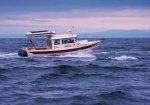If you want to study waves there are two books pretty much dedicated to the subject:
Oceanography and Seamanship by Van Dorn
Waves and Beaches by Willard Bascom.
Waves come in "sets". or "trains"and there is often one higher. The length of the "set" may vary, and the largest is usually in the center. The largest is often called a "sneaker", "sleeper" or "King" wave. In open oceans, and beaches there are "Rogue waves". which can be enormous. Often variation is caused by competing wave trains and summation of the waves.
In Deception Pass, (or any pass/inlet) when you have current agains the wind, the waves become very steep--and have a short period. Wind with the waves gives longer period, and the waves are not as steep. You also have the geological features of the pass, with varying bottom depths, and changes in width of the pass, which will react on the waves to change their pattern.
As for handling the wave: I would want to go had on--that is your best chance of survival, in a narrow pass. If you try and turn, it is almost inevitable that your boat will be rolled, especially if the height of the wave is equal to or greater than the beam of your boat, is breaking and steep. Running down the face, if the wave is equal to the LWL of your boat, then you run the chance of broaching, and pitch poling.
I have been in documented 40+ foot plus breaking seas when crossing the North Atlantic. Our boat was a full displacement, doubled ended at the waterline, with a wine glass transom, which gave a lot of buoyancy. We went diagonally down the waves, always keeping the wind behind us--trying to be no more than 30* off the center of the wave direction. We had only a storm jib (60 plus knots of wind) and the engine ticking over to keep water flow across the rudder at all times. It is essential to maintain steerage control. We were rolled to 90* several times, but never all of the way over. (which would have been catastrophic) The boats LWL was about 50 feet, and beam about 13'.
Best to avoid a situation where there is strong wind against current, going thru passes or inlets when there is maximum current with winds.
 [/code]
[/code]